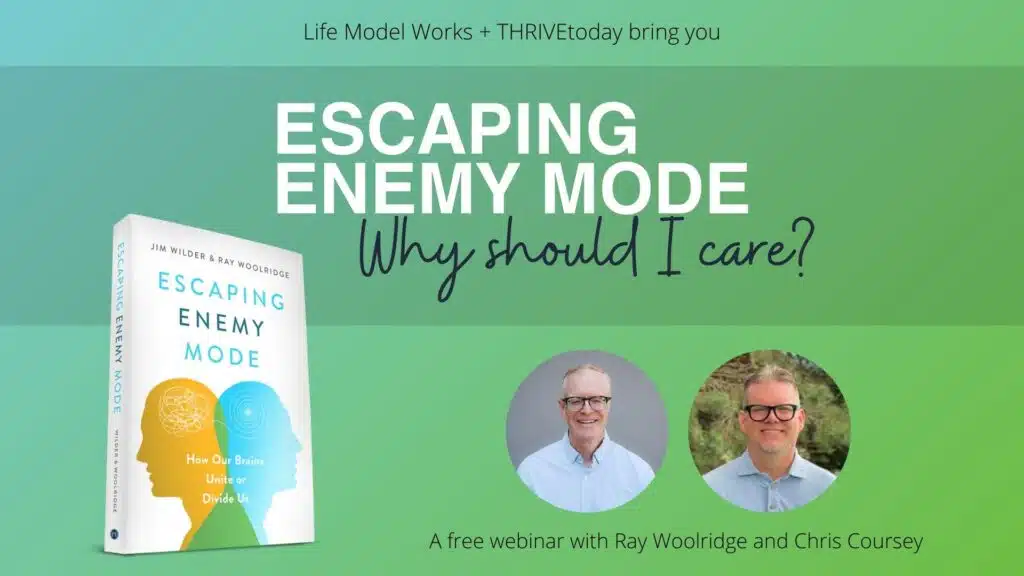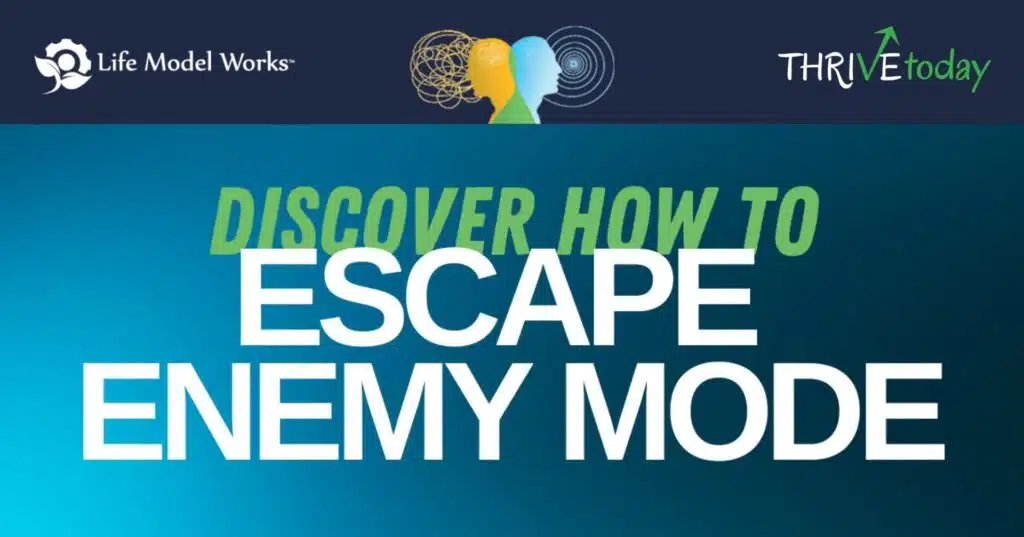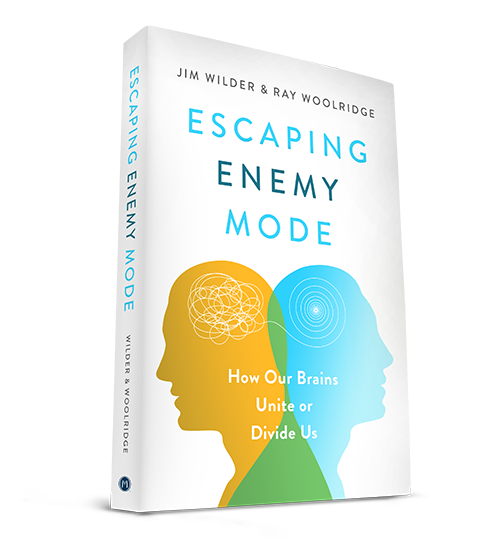
Escaping Enemy Mode
How Our Brains Unite or Divide Us
Your Brain
In Enemy Mode
Our brains are natural amplifiers, easily detecting unfriendly signals and returning them with more intensity.
Enemy mode feels as if “You are not on my side.”
We don’t like people being against us.
We don’t like the way enemy mode feels.
We become suspicious, wary, and hostile with others. Even with those trying to help us.
Could one brain state explain why we:
- Hate others?
- Stop listening?
- Stop talking?
- Start blaming?
- See others against us?
- Want them to lose?
- Unfriend them?
- Post nasty remarks online?
- Stop caring?
- Stop loving?
- Feel alienated?
- Despise a politician, race, or religious group?
- Hate others?
- Stop listening?
- Stop talking?
- Start blaming?
- See others against us?
- Want them to lose?
- Unfriend them?
- Post nasty remarks online?
- Stop caring?
- Stop loving?
- Feel alienated?
- Despise a politician, race, or religious group?
This is enemy mode.
Understanding
Enemy Mode
Understanding
Enemy Mode
Our brains can develop a damaging state of mind where we see and experience others as adversaries.
Living in enemy mode poisons family relationships, separates friends, and breaks communities apart.
Enemy mode produces relational blindness.
Even someone we love dearly can be seen as an adversary, and in this state of mind we:
Want the “enemy to lose”
Can’t discern when others are trying to help
Recruit others to attack the enemy
Feel justified in hating
See other people’s motives as “bad”
- Want the “enemy to lose”
- Can’t discern when others are trying to help
- Recruit others to attack the enemy
- Feel justified in hating
- See other people’s motives as “bad”
- Turn people into objects (not fellow humans)
- Feel alone, believing no one on my side
- Will often attack or withdraw from allies
- See enemy mode as a strength
Turn people into objects (not fellow humans)
Feel alone, believing no one on my side
Will often attack or withdraw from allies
See enemy mode as a strength
The 3 Types of
Enemy Mode
The 3 Types of
Enemy Mode

SIMPLE
It starts with the feeling someone is not on our side. An uneasy tension develops when relational connection signals are missed, ignored, mistrusted, or feared.

STUPID
A high-energy moment is fueled by "hot" anger. We destroy people and things we value or need. We sober up later realizing this person wasn't our enemy.

INTELLIGENT
This type doesn't miss signals or get stupid. "Cold" anger fills the brain with plans of resentment, revenge, hired guns, deception, even more diabolical deeds.
The Quest
to Escape
The grocery story was nearly empty when Jim heard metal hit metal. He turned to see a woman in her seventies repeatedly smashing her grocery cart into the cart of a woman half her age. It was the early 2020s—a global pandemic was raging, and enemy mode was spreading more rapidly than COVID-19. The older woman’s shouting was muffled by the mask she wore. The younger woman wore no mask. The younger woman glared silently, but belligerently, at her assailant. A man in his twenties intervened almost instantly. “Get away from her,” he told the older woman, “she is going to get you sick. Stay away from her.”
All three brains were in enemy mode.
Most shoppers would have recognized the COVID symptoms as a fever and dry cough. Few would recognize the symptoms of enemy mode in the brain as they stared at the banging carts, angry faces, and rapidly escalating hostility that was sucking them into the conflict. Instead, bystanders blamed the conflict on differing beliefs about COVID between the two ladies. Yet, shoppers who were not banging carts also held differing beliefs.
All three brains were in enemy mode.
Two leaders working alongside each other saw something unique in the midst of these experiences and knew they had to reveal the unseen processes in the brain that were dividing people so the process could be reversed.
FREE WEBINAR

Did you know that “enemy mode” is a non-relational brain state that divides us from each other, causing damage in our lives and in the world?
Join Ray Woolridge, co-author with Dr Jim Wilder of Escaping Enemy Mode: How our brains unite or divide us, and Chris Coursey, President of THRIVEtoday for this webinar filled with stories of people who are Escaping Enemy Mode.
Discover How to Escape Enemy Mode!
ONLINE COURSE

Would you like to get faster at:
Identifying relational mode and enemy mode in yourself
Recognizing the signs of enemy mode
Acknowledging enemy mode to people around you
Escaping enemy mode and shifting into joyful, relational mode
Identifying the signs of simple, stupid and intelligent enemy mode around you?
REGISTER. CONNECT. ESCAPE!
THE PODCAST
Listen as Moody Publishers engages the co-authors of Escaping Enemy Mode to discuss the problem revealed greatly during the pandemic, illustrations from real life, the neuroscience, and ultimately how to love your enemies.
What is Enemy Mode?
In this first episode of Escaping Enemy Mode, we meet Jim Wilder and Ray Woolridge. Neurotheologian Jim Wilder helps the listener understand the brain science of Enemy Mode and how much it affects the way we approach the world around us. Retired Army Brigadier General Ray Woolridge outlines his journey to discovering the presence of Enemy Mode in his life and his struggle, along with Jim, to escape it.
The 3 Enemy Modes
In this first episode of Escaping Enemy Mode, we meet Jim Wilder and Ray Woolridge. Neurotheologian Jim Wilder helps the listener understand the brain science of Enemy Mode and how much it affects the way we approach the world around us. Retired Army Brigadier General Ray Woolridge outlines his journey to discovering the presence of Enemy Mode in his life and his struggle, along with Jim, to escape it.
Engaging with Stupid Enemy Mode
Jim Wilder interviews special guest Lisa from Minneapolis. She tells the story of intervening and de-escalating a stupid enemy mode situation. Jim, Ray and Jeremy then discuss the unique features of stupid enemy mode and the best pathways for re-engaging the relational centers of the brain to escape this version of enemy mode.
Simple Enemy Mode at Home
In this episode, we hear from Chris Coursey, author of The Joy Switch. He explains a four-step process for identifying if our relational circuits are on. He helps us understand why Simple Enemy Mode threatens a thriving marriage and models pathways toward escaping enemy mode.
Intelligent Enemy Mode in the Workplace
In this episode, Ray interviews Ryan Brenneman who worked in medical device sales during the height of the COVID pandemic. He talks about how to identify intelligent enemy mode in co-workers and clients while building a team culture that banks joy instead of running on fear.
Blogs

Since 2003 and the emergence of the brain science of identity, Jim Wilder has been telling anyone who will listen that the most important missing element is the science of hate.
Emotional regulation is the mechanism of resilience but how does the brain grow cold to the humanity of others?
Recent social science has begun to say that racial prejudice is an outgrowth of the disgust emotion but, as Dr. Shore points out, disgust de-energizes the brain and body. Hate energizes people.
Social media and popular culture have taken a form of “politically correct” thinking view of hate and tied hate to certain views and opinions. However, social science is showing us that opinions are a way to gather people who hate rather than a way to creating “they are the enemy” in the brain itself. Long before views and opinions gather a group, it appears brains have concluded who the enemy is and begun the process of hating “them”.
Social media platforms, broadcast media, and internet “click bait” have proven very effective at polarizing opinions and reducing or eliminating dialogue. Families, friends, and churches are rapidly becoming alienated over vaccines, political views, human sexuality and identity.
How does the brain decide that someone is not on my side and begin an alienation process? How do we escape being dragged along?
The book Escaping Enemy Mode engages a much broader audience than the church. Why? Because lots of people are in some degree of enemy mode with the church. People are leaving church while others see Christian beliefs as the cause for social discord. On the other hand, there are about 2.3 billion people on earth who claim to be Christian. It is the world’s largest religion.
Ray Woolridge set out to see if loving enemies, as Jesus taught, fits with escaping enemy mode. Jim Wilder set out to discover how the brain gets alienated from others – from simply seeing others as transactions to the full depersonalization of hate and genocide.
Can escaping enemy mode provide better paths forward around race and other sources of alienation?
We are about to find out.
by Rev. Ray Woolridge, Oct 17, 2022

Enemy Mode and Hate
The most important missing element is the science of hate. Emotional regulation is the mechanism of resilience but how does the brain grow cold to the humanity of others?

Since 2003 and the emergence of the brain science of identity, Jim Wilder has been telling anyone who will listen that the most important missing element is the science of hate.
Emotional regulation is the mechanism of resilience but how does the brain grow cold to the humanity of others?
Recent social science has begun to say that racial prejudice is an outgrowth of the disgust emotion but, as Dr. Shore points out, disgust de-energizes the brain and body. Hate energizes people.
Social media and popular culture have taken a form of “politically correct” thinking view of hate and tied hate to certain views and opinions. However, social science is showing us that opinions are a way to gather people who hate rather than a way to creating “they are the enemy” in the brain itself. Long before views and opinions gather a group, it appears brains have concluded who the enemy is and begun the process of hating “them”.
Social media platforms, broadcast media, and internet “click bait” have proven very effective at polarizing opinions and reducing or eliminating dialogue. Families, friends, and churches are rapidly becoming alienated over vaccines, political views, human sexuality and identity.
How does the brain decide that someone is not on my side and begin an alienation process? How do we escape being dragged along?
The book Escaping Enemy Mode engages a much broader audience than the church. Why? Because lots of people are in some degree of enemy mode with the church. People are leaving church while others see Christian beliefs as the cause for social discord. On the other hand, there are about 2.3 billion people on earth who claim to be Christian. It is the world’s largest religion.
Ray Woolridge set out to see if loving enemies, as Jesus taught, fits with escaping enemy mode. Jim Wilder set out to discover how the brain gets alienated from others – from simply seeing others as transactions to the full depersonalization of hate and genocide.
Can escaping enemy mode provide better paths forward around race and other sources of alienation?
We are about to find out.
by Rev. Ray Woolridge, Oct 17, 2022

During the two long years Jim Wilder and I invested in writing Escaping Enemy Mode, opportunities to practice what we were learning were frequent.
I often found myself lamenting my enemy mode failures.
As buoyed as I might have been by an occasional successful escape, the damage my enemy mode had caused brought sadness, pain, regret and the determination to escape enemy mode at all costs.
Our writing and research were fueled by a profusion of personal examples, observation of the damage caused by enemy mode around us, and the storytellers who filled us with their tales of enemy mode exposures and escapes. Many stories were like this one from not too long ago when my enemy mode tendencies almost did some damage.
Becoming relational takes time as neural pathways (FAST track) get retrained.
I almost fell into a well-worn path in a discussion that ended relationally but could have taken a turn.
My wife Deborah and I were moving out of state this summer. After hundreds of hours on house hunting websites, we had found just the right place. We wanted to tour it but wondered “where did the bedroom hallway begin?”
She felt the hallway entry was at the front. I countered: “It has to start in the middle.” I knew I was right.
The discussion felt like a debate. Fun for a while, it changed to “just on the edge” of not being fun. I felt tension rising in my chest. She felt uncomfortable and almost wanted to stop talking about it.
We were at an impasse. In these types of situations in the past, it has been normal for me to go into enemy mode. The next few minutes I would not have been my best self. I would prove my point. I would win!
That didn’t happen this time. What helped? I am a Christian, so I wondered “what did Jesus have to say about this?”
Deborah was first to notice what was happening between us. She felt the tension before I did. I had noticed my tightening chest but not done anything to quiet myself. She wisely suggested, “you and I just have hypotheses. We can’t tell from the photos, so we don’t know. We’ll have to see.” I agreed with her, “Yes, we’ll see tomorrow!”
She was my “rescue attachment.” She helped me realize we could win the discussion together. I quieted my body a little. I remembered she was on my side and listened to her. Our discussion had taken forty-five minutes, thanks to me. We ended the discussion relationally and agreed to disagree, thanks to Deborah.
During the next day’s virtual tour, we discovered where the hallway began. It turns out we had been both saying the same thing, but I didn’t notice at the time.
Why? Because I was slipping into enemy mode. I was not curious about what she was thinking, which indicates enemy mode in the brain.
We got our “hallway entry” answer, but we are still working every day to stay out of enemy mode. This was a tiny victory on the road to transformation. When Deborah and I later reflected on this episode, we felt tender towards each other and thankful to possibly have a new home to live in.
Better, we felt we had been together in it and had acted like our best selves.
Better yet, we both felt Jesus was with us, and was pleased with the new way we navigated what could have been painful.
by Rev. Ray Woolridge, Oct 16, 2022

Relational Discussion or Enemy Mode Argument?
While looking at pictures of homes for sale, my wife and I had a discussion than soon felt like a debate. I knew I was right. I was on the edge of enemy mode.

During the two long years Jim Wilder and I invested in writing Escaping Enemy Mode, opportunities to practice what we were learning were frequent.
I often found myself lamenting my enemy mode failures.
As buoyed as I might have been by an occasional successful escape, the damage my enemy mode had caused brought sadness, pain, regret and the determination to escape enemy mode at all costs.
Our writing and research were fueled by a profusion of personal examples, observation of the damage caused by enemy mode around us, and the storytellers who filled us with their tales of enemy mode exposures and escapes. Many stories were like this one from not too long ago when my enemy mode tendencies almost did some damage.
Becoming relational takes time as neural pathways (FAST track) get retrained.
I almost fell into a well-worn path in a discussion that ended relationally but could have taken a turn.
My wife Deborah and I were moving out of state this summer. After hundreds of hours on house hunting websites, we had found just the right place. We wanted to tour it but wondered “where did the bedroom hallway begin?”
She felt the hallway entry was at the front. I countered: “It has to start in the middle.” I knew I was right.
The discussion felt like a debate. Fun for a while, it changed to “just on the edge” of not being fun. I felt tension rising in my chest. She felt uncomfortable and almost wanted to stop talking about it.
We were at an impasse. In these types of situations in the past, it has been normal for me to go into enemy mode. The next few minutes I would not have been my best self. I would prove my point. I would win!
That didn’t happen this time. What helped? I am a Christian, so I wondered “what did Jesus have to say about this?”
Deborah was first to notice what was happening between us. She felt the tension before I did. I had noticed my tightening chest but not done anything to quiet myself. She wisely suggested, “you and I just have hypotheses. We can’t tell from the photos, so we don’t know. We’ll have to see.” I agreed with her, “Yes, we’ll see tomorrow!”
She was my “rescue attachment.” She helped me realize we could win the discussion together. I quieted my body a little. I remembered she was on my side and listened to her. Our discussion had taken forty-five minutes, thanks to me. We ended the discussion relationally and agreed to disagree, thanks to Deborah.
During the next day’s virtual tour, we discovered where the hallway began. It turns out we had been both saying the same thing, but I didn’t notice at the time.
Why? Because I was slipping into enemy mode. I was not curious about what she was thinking, which indicates enemy mode in the brain.
We got our “hallway entry” answer, but we are still working every day to stay out of enemy mode. This was a tiny victory on the road to transformation. When Deborah and I later reflected on this episode, we felt tender towards each other and thankful to possibly have a new home to live in.
Better, we felt we had been together in it and had acted like our best selves.
Better yet, we both felt Jesus was with us, and was pleased with the new way we navigated what could have been painful.
by Rev. Ray Woolridge, Oct 16, 2022

Enemy mode affects us even if we don’t notice it.
Just like asbestos, second-hand smoke or bad drinking water, exposure to enemy mode affects everyone.
Don’t think you’ve been impacted by enemy mode?
What’s your answer to these questions? Any “yes” means you have been exposed. The more “yes” answers, the higher your exposure!
Test your risk of enemy mode exposure: A “yes” means you have lived through enemy mode.
Have your parents, adult children or you been divorced? Then you have lived through enemy mode.
Have you or your children participated in organized sports? Then you have seen parents, coaches and players in enemy mode.
Do you or any of your immediate family serve in the military? Are you a veteran? Then you have lived through enemy mode.
Have you been a victim of a crime? Then you have lived through enemy mode.
Have you been in court? Then you have lived through enemy mode.
Do you work in sales, contracts, human relations or customer complaints? Getting people out of enemy mode is your job.
Do you or your close family serve in law enforcement? Limiting enemy mode is your job.
Did you go to recess with other children, have teachers who yelled or disliked certain students or views? You have lived through enemy mode.
Have you been unfriended on social media? You have lived through enemy mode.
Are you an indigenous person or belong to an unfavored group? You have lived through enemy mode.
Are your leaders elected (and especially if they are not)? You live under people in frequent enemy mode.
Do you watch TV and movies? You are exposed to enemy mode by the hour.
Have you been impacted by gangs, tribal hostilities, colonialism, police states, lack of access to food and medicine, persecution or discrimination? You have lived through enemy mode.
You carry the residual effects of enemy mode if:
You or your ancestors remember being displaced.
Your family lived through a war in the last four generations.
You or your ancestors immigrated.
Your people lost their lands to others.
Your people were enslaved or owned slaves.
Your people were subject to genocide in the last two centuries.
Lots of these conditions generate enemy mode. Yet people in every generation arise, escape enemy mode and help others to do so as well. Others become bitter, chronically fearful, and combative.
You can learn to escape enemy mode. Join the escape!
by Rev. Ray Woolridge, Oct 14, 2022

Exposure to Enemy Mode
Just like asbestos, second-hand smoke or bad drinking water, exposure to enemy mode affects everyone. Test your exposure with these questions.

Enemy mode affects us even if we don’t notice it.
Just like asbestos, second-hand smoke or bad drinking water, exposure to enemy mode affects everyone.
Don’t think you’ve been impacted by enemy mode?
What’s your answer to these questions? Any “yes” means you have been exposed. The more “yes” answers, the higher your exposure!
Test your risk of enemy mode exposure: A “yes” means you have lived through enemy mode.
Have your parents, adult children or you been divorced? Then you have lived through enemy mode.
Have you or your children participated in organized sports? Then you have seen parents, coaches and players in enemy mode.
Do you or any of your immediate family serve in the military? Are you a veteran? Then you have lived through enemy mode.
Have you been a victim of a crime? Then you have lived through enemy mode.
Have you been in court? Then you have lived through enemy mode.
Do you work in sales, contracts, human relations or customer complaints? Getting people out of enemy mode is your job.
Do you or your close family serve in law enforcement? Limiting enemy mode is your job.
Did you go to recess with other children, have teachers who yelled or disliked certain students or views? You have lived through enemy mode.
Have you been unfriended on social media? You have lived through enemy mode.
Are you an indigenous person or belong to an unfavored group? You have lived through enemy mode.
Are your leaders elected (and especially if they are not)? You live under people in frequent enemy mode.
Do you watch TV and movies? You are exposed to enemy mode by the hour.
Have you been impacted by gangs, tribal hostilities, colonialism, police states, lack of access to food and medicine, persecution or discrimination? You have lived through enemy mode.
You carry the residual effects of enemy mode if:
You or your ancestors remember being displaced.
Your family lived through a war in the last four generations.
You or your ancestors immigrated.
Your people lost their lands to others.
Your people were enslaved or owned slaves.
Your people were subject to genocide in the last two centuries.
Lots of these conditions generate enemy mode. Yet people in every generation arise, escape enemy mode and help others to do so as well. Others become bitter, chronically fearful, and combative.
You can learn to escape enemy mode. Join the escape!
by Rev. Ray Woolridge, Oct 14, 2022
![]()
A number of years ago, my wife Kitty decided to surprise our family and guests for Thanksgiving with a meal based on her recent fascination with a raw plant-based diet. The first clue was a platter with a lump about the size and shape of a small chicken that she called the turkey. The lump was made primarily of raw nuts and naturally cold. This avatar replaced the turkey.
In the same way, an avatar made of raw cauliflower replaced mashed potatoes. Something with carob power and avocado replaced chocolate. But, the raw blueberry pie did actually contain blueberries. The “coffee” was a brown liquid, I will grant that point. In every case but the blueberries, nothing was what it claimed to be.
We also, in order to present what we consider to be a healthier version of being Christians, have a tendency to create an avatar self using the “as-if” functions of our dorsomedial prefrontal cortex. (You can read more about that in Escaping Enemy Mode.) The people closest to us, those seated around the Thanksgiving table, easily notice the difference between our avatar identities and who they know to be real.
We can look at this raw food meal a different way, as well. A healthy diet would be an acquired taste for most of us. The raw nut lump would, if we didn’t try to think of it as turkey, actually taste pretty good. I cannot extend the same courtesy to the “coffee” substitute.
Our true and best selves are also an acquired taste and something quite unexpected. St. John tells us, “Dear friends, now we are children of God, and what we will be has not yet been made known. But we know that when Christ appears, we shall be like him, for we shall see him as he is.“ 1 John 3:2 NIV.
We are in the middle of becoming someone who has never been here before.
We can create our own avatars and “as-if” selves or we can become more than we could imagine – a new self of God’s design. A truly new self is an acquired taste and a reason for thanksgiving.
Who will gather around your table?
by Rev. Ray Woolridge, Oct 13, 2022
Avatars and Avocados
We can create our own avatars and “as-if” selves or we can become more than we could imagine – a new self of God’s design.
![]()
A number of years ago, my wife Kitty decided to surprise our family and guests for Thanksgiving with a meal based on her recent fascination with a raw plant-based diet. The first clue was a platter with a lump about the size and shape of a small chicken that she called the turkey. The lump was made primarily of raw nuts and naturally cold. This avatar replaced the turkey.
In the same way, an avatar made of raw cauliflower replaced mashed potatoes. Something with carob power and avocado replaced chocolate. But, the raw blueberry pie did actually contain blueberries. The “coffee” was a brown liquid, I will grant that point. In every case but the blueberries, nothing was what it claimed to be.
We also, in order to present what we consider to be a healthier version of being Christians, have a tendency to create an avatar self using the “as-if” functions of our dorsomedial prefrontal cortex. (You can read more about that in Escaping Enemy Mode.) The people closest to us, those seated around the Thanksgiving table, easily notice the difference between our avatar identities and who they know to be real.
We can look at this raw food meal a different way, as well. A healthy diet would be an acquired taste for most of us. The raw nut lump would, if we didn’t try to think of it as turkey, actually taste pretty good. I cannot extend the same courtesy to the “coffee” substitute.
Our true and best selves are also an acquired taste and something quite unexpected. St. John tells us, “Dear friends, now we are children of God, and what we will be has not yet been made known. But we know that when Christ appears, we shall be like him, for we shall see him as he is.“ 1 John 3:2 NIV.
We are in the middle of becoming someone who has never been here before.
We can create our own avatars and “as-if” selves or we can become more than we could imagine – a new self of God’s design. A truly new self is an acquired taste and a reason for thanksgiving.
Who will gather around your table?
by Rev. Ray Woolridge, Oct 13, 2022
Buy The Book
BUY NOW
The book was released November 1st and is shipping today!
Get the study guide
Scroll to the next section and get the Study Guide FREE and you'll only find it here.
love your enemies
The book was released November 1st and is shipping today!

Exclusive: Free Study Guide!
The Study Guide is available now and exclusively from this website.
You will want to have this open when your copy of Escaping Enemy Mode arrives to enhance your understanding of the topic, grasp the concepts for application, and journal your transformation.
We will email the Study Guide to you!
CONTACT US
We are looking forward to hearing from you, even if you hate us.
Let us know how we can help you, particularly if it means escaping enemy mode.


